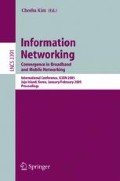Abstract
Multi-hop ad hoc wireless networks generally use the IEEE 802.11 Distributed Coordination Function (DCF) MAC protocol, which utilizes the request-to-send/clear-to-send (RTS/CTS) mechanism to prevent the hidden terminal problem. It has been pointed out that the RTS/CTS mechanism cannot completely solve the hidden terminal problem in ad hoc networks because the interference range could exceed the basic rate transmission range. In this paper we provide a worst-case analysis of collision probability induced by the hidden terminal problem in ad hoc networks with multi-rate functionality. We show that the interference caused by the nodes in the area that is not covered by the RTS/CTS is bounded by C′R − 4, where C′ is a constant and R is the distance between the two transmitting nodes. The analytic result showed that the interference could shorten the data transmission range up to 30 percent. We then propose a simple multi-rate MAC protocol that could prevent the hidden terminal problem when transmit power control (TPC) is employed.
This work was supported by the Brain Korea 21 Project in 2004 and grant No.R01-2001-00360 from the Korea Science and Engineering Foundation.
Access this chapter
Tax calculation will be finalised at checkout
Purchases are for personal use only
Preview
Unable to display preview. Download preview PDF.
References
IEEE standard for Wireless LAN Medium Access Control (MAC) and Physical Layer (PHY) specifications. ISO/IEC 8802-11 (1999(E)) (August 1999)
Kamerman, A., Monteba, L.: WaveLAN II: A high-performance wireless LAN for the unlicensed band. Bell Labs Technical Journal, 118–133 (1997)
Holland, G., Vaidya, N., Bahl, P.: A Rate-Adaptive MAC Protocol for Multi-Hop Wireless Networks. In: Proc. ACM Mobicom 2001 (2001)
Xu, K., Gerla, M., Bae, S.: How Effective is the IEEE 802.11 RTS/CTS Handshake in Ad Hoc Networks? In: Proc. IEEE Globecom 2002 (2002)
Rappaport, T.: Wireless Communications: Principles and Practice. Prentice Hall, New Jersey (1996)
Agere Systems Chipset, http://www.agere.com
Qiao, D., Choi, S., Jain, A., Shin, K.: MiSer: An Optimal Low-Energy Transmission Strategy for IEEE 802.11a/h. In: Proc. ACM Mobicom 2003 (2003)
Author information
Authors and Affiliations
Editor information
Editors and Affiliations
Rights and permissions
Copyright information
© 2005 Springer-Verlag Berlin Heidelberg
About this paper
Cite this paper
Yoo, J., Kim, C. (2005). On the Hidden Terminal Problem in Multi-rate Ad Hoc Wireless Networks. In: Kim, C. (eds) Information Networking. Convergence in Broadband and Mobile Networking. ICOIN 2005. Lecture Notes in Computer Science, vol 3391. Springer, Berlin, Heidelberg. https://doi.org/10.1007/978-3-540-30582-8_50
Download citation
DOI: https://doi.org/10.1007/978-3-540-30582-8_50
Publisher Name: Springer, Berlin, Heidelberg
Print ISBN: 978-3-540-24467-7
Online ISBN: 978-3-540-30582-8
eBook Packages: Computer ScienceComputer Science (R0)

